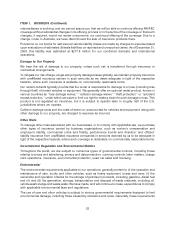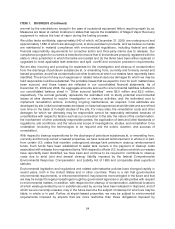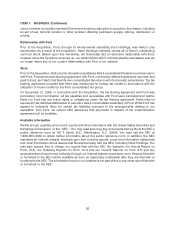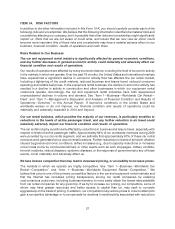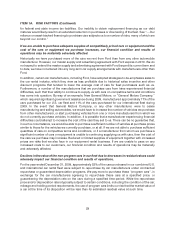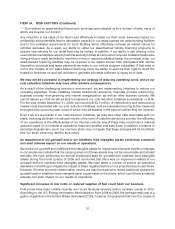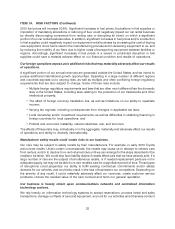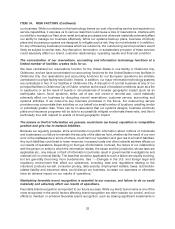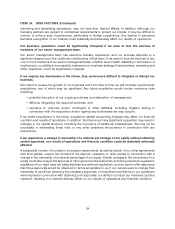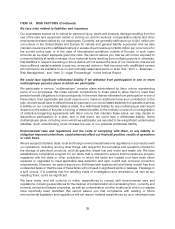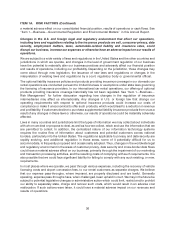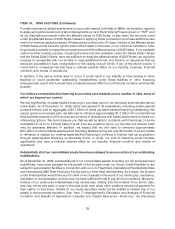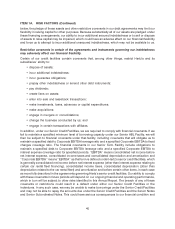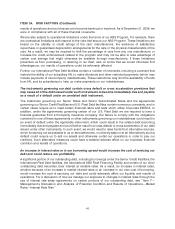Hertz 2009 Annual Report Download - page 51
Download and view the complete annual report
Please find page 51 of the 2009 Hertz annual report below. You can navigate through the pages in the report by either clicking on the pages listed below, or by using the keyword search tool below to find specific information within the annual report.ITEM 1A. RISK FACTORS (Continued)
‘‘—Our reliance on asset-backed financing to purchase cars subjects us to a number of risks, many of
which are beyond our control.’’
Any reduction in the value of our fleet could effectively increase our fleet costs, adversely impact our
profitability and potentially lead to decreased capacity in our asset backed car rental funding facilities
due to the collateral requirements for such facilities which effectively increase as market values for
vehicles decrease. As a result, our ability to utilize our asset-backed vehicle financing programs to
acquire new vehicles for our rental fleet may be limited. In addition, if our ability to sell vehicles in the
used vehicle marketplace were to become severely limited at a time when required collateral levels were
rising and as a result we failed to meet the minimum required collateral levels, the principal under our
asset-backed financing facilities may be required to be repaid sooner than anticipated with vehicle
disposition proceeds and lease payments we make to our vehicle program subsidiary. If that were to
occur, the holders of our asset-backed debt may have the ability to exercise their right to direct the
trustee to foreclose on and sell vehicles to generate proceeds sufficient to repay such debt.
We may not be successful in implementing our strategy of reducing operating costs, and/or our
cost reduction initiatives may have other adverse consequences.
As a result of the challenging economic environment, we are implementing initiatives to reduce our
operating expenses. These initiatives include headcount reductions, business process outsourcing,
business process re-engineering and internal reorganization, as well as other expense controls. We
cannot assure you that we will be able to implement our cost reduction initiatives successfully, or at all.
For the year ended December 31, 2009, we incurred $153.3 million of restructuring and restructuring
related costs associated with our cost reduction initiatives, and we anticipate incurring further expenses
throughout the upcoming year, some of which may be material in the period in which they are incurred.
Even if we are successful in our cost reduction initiatives, we may face other risks associated with our
plans, including declines in employee morale or the level of customer service we provide, the efficiency
of our operations or the effectiveness of our internal controls. Any of these risks could have a material
adverse impact on our results of operations, financial condition and cash flows. In addition, investors or
securities analysts who cover our common stock may not agree that these changes will be beneficial,
and our stock price may decline as a result.
An impairment of our goodwill and/or our indefinite lived intangible assets could have a material
non-cash adverse impact on our results of operations.
We review our goodwill and indefinite lived intangible assets for impairment whenever events or changes
in circumstances indicate that the carrying amount of these assets may not be recoverable and at least
annually. We have performed our annual impairment tests for goodwill and indefinite lived intangible
assets during the fourth quarter of 2009 and concluded that there was no impairment related to our
goodwill and our indefinite-lived intangible assets. We have taken a number of actions as described
elsewhere in this filing to mitigate the impact of these negative factors on our projected future cash flows.
However, if further economic deterioration occurs, we may be required to record additional charges for
goodwill and/or indefinite lived intangible asset impairments in the future, which could have a material
adverse non-cash impact on our results of operations.
Significant increases in fuel costs or reduced supplies of fuel could harm our business.
Fuel prices have been volatile recently, and could fluctuate severely and/or increase overall in 2010.
According to the U.S. Energy Information Administration, from 2008 to 2009, the average retail cost of a
gallon of gasoline in the United States decreased 27.9%, however it is projected that over the course of
31




